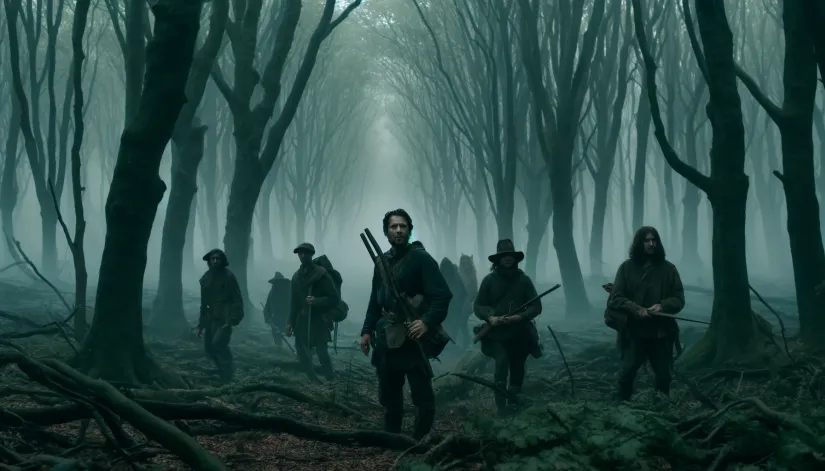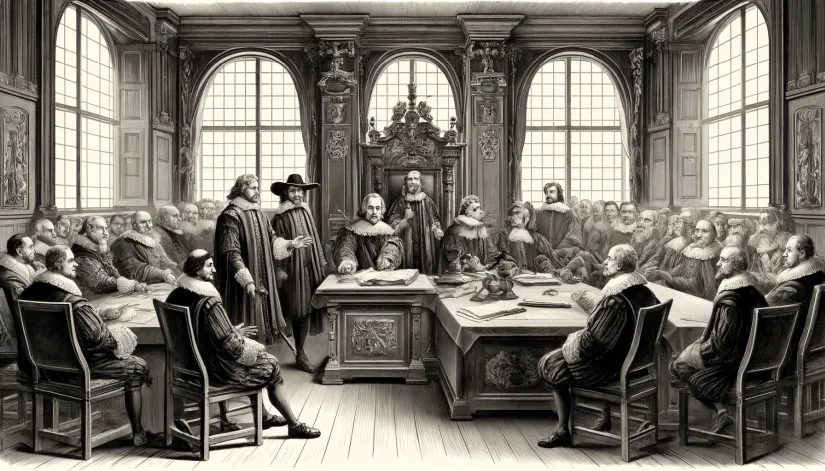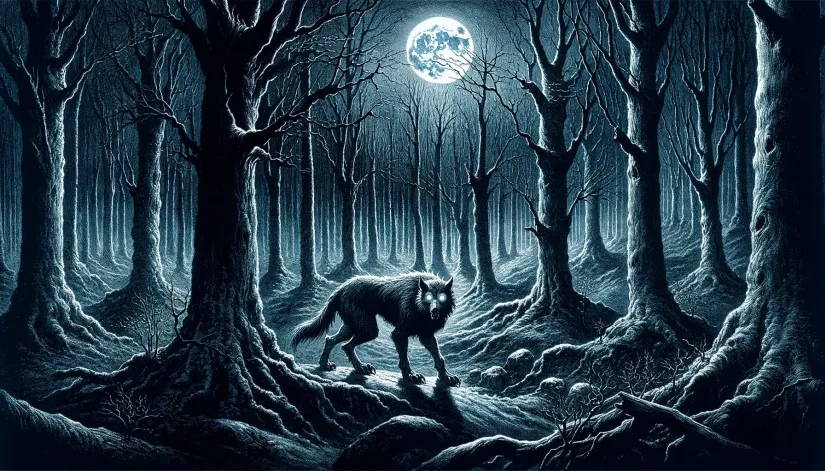Jacques Roulet (also known as the Werewolf of Angers or the Werewolf of Caud) was a mysterious figure from 1598 associated with a gruesome murder case after he was found half-naked in the woods near the mutilated body of a 15-year-old boy.
Roulet was initially suspected of murder and cannibalism but later confessed to being a werewolf (claiming he had been given a salve by his parents that transformed him into a wolf).
He also claimed that his brother and cousin had similar supernatural abilities.
But what exactly happened? And was there any truth in Roulet’s confessions? Was he indeed a werewolf or just another deeply troubled individual? And why is Jacques Roulet’s case still one of the most well-known cases of alleged lycanthropy in history?
In this article:
The Mysterious Case of Jacques Roulet
Only a handful of records exist about those fateful events. And—just to make things even worse—most of these accounts are contradictory.
However, the information we can gather is sufficient to picture and put together what happened.
On a brisk fall morning in 1598, a thick fog hung over the woods near Angers (a small town in western France, located in the Loire Valley), wrapping the ground in a blanket of mystery and quiet.
The villagers (used to the rhythms of the forest) didn’t pay much attention to its mystical embrace. They went about their daily chores with the quiet acceptance of those who had made peace with the land and its secrets.
But as the sun climbed higher—slicing through the fog with beams of golden light—a group of woodcutters made a gruesome discovery.

Partially covered by twisted roots and stones lay the mutilated body of a teenage boy—the same boy who had gone missing a few days earlier. His wounds were savage, with unmistakable teeth and claw marks.
Horrified, the woodcutters rushed back to the village. Their grim news spread like wildfire. How could this be possible? What happened? And what sort of dreadful beast could have been responsible for such an atrocity?
Interesting fact:
According to another version of the story, Roulet was discovered by two hunters who initially came across two wolves feeding on the body of the teenage boy. When they chased the wolves, they found Roulet nearby, covered in blood and with flesh under his fingernails. This scene was what convinced the villagers that Roulet was, in fact, a werewolf.
Some townspeople armed themselves with rudimentary weapons and formed a search party, heading back into the woods. Many were convinced that a wolf—or maybe a bear—could be responsible.
But some were also talking about something else—something supernatural.
A werewolf? Could a wolf-like monster be lurking near their town? Those cursed beings capable of shedding their human form to take on the guise of a wolf?
Not far from where the body was found, one of the villagers spotted a mysterious man.
The man (later identified as Jacques Roulet) was half-naked, with long hair and a beard, his hands stained with blood, and his nails clotted with fresh gore and human flesh.
He was immediately apprehended.
This grim discovery marked the beginning of the enigmatic and horrifying saga of Jacques Roulet, a figure whose story weaves through the darkest threads of folklore and history.
Jacques Roulet’s Bizarre Confessions
Jacques Roulet’s story took an even as the wheels of justice began to turn.
According to records, the clearly troubled Roulet admitted after his arrest to killing the boy by smothering him. He also confessed to other murders and cannibalism.
But here’s something interesting that sets Roulet’s bizarre case apart from other famous werewolf cases.
There’s no mention in the historical records of Roulet admitting to witchcraft or dealing with the Devil (both common confessions from those accused of being werewolves).
Instead, Roulet claimed he could transform into a wolf using a special salve his parents had given him.
Did you know?
After being imprisoned, Jacques Roulet exhibited bizarre behavior, such as drinking an entire pail of water at once and then refusing to eat or drink anything for days. This erratic behavior contributed to the authorities’ decision to commute his death sentence to imprisonment in an asylum, as they deemed him mentally unstable rather than a true werewolf.
He also implicated his brother Jean (John) and cousin Julien as fellow werewolves. In his troubled mind, lycanthropy was likely some sort of family trait.
Now, here’s another remarkable aspect: all these “admissions” came without the coercion of torture, distancing Roulet’s narrative from the typical witchcraft and werewolf cases.

Jacques Roulet’s trial
The trial took place soon after his 1598 apprehension in the same Angers, France.
And, as it was customary in that period, Roulet’s case was a spectacle of legal norms clashing with superstition, where forensic science was nonexistent, and the weight of evidence lay heavily on confession and public fear.
During the trial, Roulet allegedly recognized the victim’s clothes, correctly identified the day and place from which the boy disappeared, and recognized the boy’s father (who was present at the trial and among the first villages who went to search for the missing boy).
However, Roulet’s respectable and devout parents were able to prove that both Jean and Julien were nowhere near the crime location and had nothing to do with the heinous act committed by their friend. And the judge believed them.
Here is a translation of an excerpt from the chilling testimony of Jacques Roulet as it was recorded:
[Judge Pierre Hérault]: “What are your name and title?”
[Jacques Roulet]: “My name is Jacques Roulet. I am thirty-five years old. I am poor.”
[Judge Pierre Hérault]: “What specifically are you accused of?”
[Jacques Roulet]: “Of being a thief, of insulting God. My parents gave me an ointment. I don’t know its composition.”
[Judge Pierre Hérault]: “When you use this ointment, do you become a wolf?”
[Jacques Roulet]: “I don’t transform, but nevertheless, I killed and ate Cornier’s child. I was a beast.”
[Judge Pierre Hérault]: “Were you dressed as a wolf?”
[Jacques Roulet]: “I was dressed as I am now. My hands and face were covered in blood because I had eaten the mentioned child’s flesh.”
[Judge Pierre Hérault]: “Do your hands and feet turn into wolf paws?”
[Jacques Roulet]: “Yes, that’s what happens.”
[Judge Pierre Hérault]: “Does your head also transform into a wolf’s head? Does your mouth become larger?”
[Jacques Roulet]: “I don’t know what my head was like then. I used my teeth, and my head was as it is today. I have hurt and eaten many other small children.”

The Sentence and Reevaluation
Jacques Roulet’s trial ended with a shocking and unexpected twist. Initially, the Lieutenant Criminel of Angers sentenced him to death for murder, werewolfism, and cannibalism.
However, Roulet appealed to the Parliament of Paris, which overturned the death sentence.
Instead, he was sent to a mental institution for two years due to doubts about his mental state during the confession.
This unexpected turn of events spared Jacques Roulet from execution and led to his confinement for further evaluation.
Given all we know about Europe’s 16th-century judicial procedures, the simple fact that Roulet was not executed is almost unheard of.
So, how can we explain that? Well, we believe a few factors may have contributed to this:
Mental State and Insanity Defense
One of the primary reasons Roulet was not executed was the doubt cast on his mental state during his confession.
His erratic behavior and the nature of his claims (transforming into a wolf with a salve given by his parents) likely led authorities to question his sanity.
During this period, while the understanding of mental illness was rudimentary, there was a recognition that those deemed insane might not be fully responsible for their actions.
Context of the Werewolf Panic
The 16th century was a time of widespread fear and hysteria about werewolves, leading to many executions based on dubious evidence and confessions often extracted under torture (like in the cases of Peter Stumpp or Gilles Garnier).
In Roulet’s case, the Parliament of Paris may have been more cautious, recognizing the potential for wrongful execution based on hysteria rather than solid evidence.
Influence of Religious and Philosophical Shifts
The late 16th century was a period of significant religious and philosophical changes.
The Reformation (and the subsequent Catholic Counter-Reformation) prompted deeper inquiries into justice, morality, and the treatment of the accused.
In fact, there was an increasing tendency to view confessions obtained under duress skeptically and a growing belief in humane treatment for those deemed mentally ill.
Medical and Legal Perspective on Lycanthropy
Roulet’s case also prompts a reexamination of lycanthropy from both a medical and legal standpoint.
Historically viewed as a form of delusion or mental illness, lycanthropy challenges the boundaries between the scientific and the supernatural.
By reevaluating Roulet’s sentence and opting for his commitment to an asylum, the Parliament of Paris (a higher judicial authority), indirectly acknowledged the potential for a medical explanation behind what was traditionally seen as a supernatural affliction.
This shift reflects a nascent but growing awareness of the complexities of the human mind and the limitations of 16th-century forensic science.

Witchcraft, Superstition, and the Werewolf Trials
So, was Jacques Roulet a werewolf? Obviously not. He was a deeply troubled individual who barely escaped execution for his crimes.
But we should all remember that the historical context is important here.
This whole case happened in the late 16th century, a time rife with a burgeoning interest in the occult sciences. It was the perfect setting for a tale of lycanthropy and murder.
During the 16th century, Europe was gripped by gruesome witch hunts and trials, often fueled by superstitions and fear. The case of Jacques Roulet was part of this broader context of paranoia and belief in supernatural phenomena.
Luckily, we can now take a look at the bigger picture. And better analyze the historical context. Step by step. We can now glance at everything that happened during Jacques’s confessions, trial, and sentence. And it all starts to make a bit more sense.
The idea of being a werewolf taps into existing beliefs in werewolfism, a notion deeply rooted in European folklore. The concept of humans transforming into wolves or other animals was a common theme in myths and legends.
Even the infamous, mysterious salve, with allegedly magical powers, fits well into this narrative.
Roulet’s belief in magical ointments (or potions) contributing to transformations was consistent with folklore surrounding werewolves.
In fact, Roulet’s case—set against the backdrop of other notable werewolf trials such as those of Gilles Garnier and Peter Stumpp— highlights a period rife with werewolf hysteria fueled by influential figures like Jean Bodin and Pierre de Lancre.
This era, marked by a collective fear of the unknown, witnessed the conflation of lycanthropy with witchcraft and devil pacts, reflecting a society grappling with the complexities of faith, fear, and the desire for order.
Fact vs. Fiction: Potential Psychological and Sociological Explanations
So, Roulet wasn’t a werewolf.
When you look at the historical evidence alongside Roulet’s confessions and all those wild stories about his transformations, it really highlights how tough it is to separate fact from fiction in historical narratives.
The idea of corpus delicti, which is super important in legal cases, gets really tricky with werewolves because you can’t actually prove supernatural stuff happened.
As a matter of fact, this very lack of hard evidence can make you question how reliable historical records are—since they often mirror the superstitions and fears of their time instead of solid facts.
So, here are some potential explanations for Roulet’s claims (and other similar ones):
Theory 1: Mental Health Issues
This may actually be the most obvious one. Roulet might have suffered from a psychological disorder (such as schizophrenia or perhaps a dissociative identity disorder).
He BELIEVED he was a werewolf. And that belief may have led him to commit acts he later attributed to such a transformation.
Plus, psychotic episodes could have induced hallucinations or delusions of transforming into a beast.
Theory 2: Lycanthropy Syndrome
This is a rare psychiatric syndrome where the person has a delusion that they can transform into a wolf.
This condition (which is known today but not fully understood by modern psychology) might explain why individuals like Roulet genuinely believed in their werewolf identity.
Theory 3: Social and Cultural Beliefs
As mentioned, in the 16th century, folklore and superstitions heavily influenced societal norms and beliefs.
Stories of werewolves and other supernatural beings were common. So, it’s not entirely crazy to imagine how beliefs in such creatures could have influenced Roulet’s perceptions of himself—especially if most people he came in contact with also had strong beliefs in the supernatural.
Theory 4: Scapegoating
What is scapegoating? In simple terms, it is a psychological and sociological mechanism through which some communities manage internal conflicts, fears, and frustrations during times of social unrest or hardship.
Given that, we think that the scapegoating theory can also be relevant to Jacques Roulet’s werewolf story.
During times of uncertainty, economic hardship, disease, or famine, communities often look for explanations or outlets for their collective anxieties.
So what the community does? It identifies a scapegoat. A common enemy that can help everyone join in a fight against a common threat. No matter if this scapegoat is an individual or group accused of causing the community’s misfortunes through evil means.
Roulet—probably because of his shocking confession of lycanthropy and cannibalism—provided a perfect candidate for this role.
By labeling Roulet as a werewolf—a creature already associated with evil and destruction—the locals could channel their fears and frustrations into action against him.
Theory 5: Confession under Duress
Now, there is no evidence that Roulet’s confessions were obtained under torture.
However—even in the absence of physical torture—the psychological strain exerted by intense interrogation sessions and the looming threat of execution could profoundly impact a person’s mental state and decision-making process.
In Roulet’s case, several factors might have converged to compel a confession (regardless of its veracity).
The interrogation environment itself (typically characterized by isolation, fear, and the existence of authority figures) can create immense psychological stress.
This stress can potentially break down someone’s resistance and coerce them to confess to crimes they did not commit. Just to escape from the immediate situation.

Theory 6: Folk Medicine and Altered States
Herbs, mushrooms, and other natural substances were deeply entwined with healing and spiritual practices in 16th-century Europe.
Many of these substances—some known for their psychoactive properties—could significantly alter a person’s mental state, perceptions, and behaviors.
Some common plants include belladonna (Atropa belladonna), mandrake (Mandragora officinarum), and various species of nightshades and fungi.
When ingested in certain quantities, these can cause hallucinations, delirium, and a sense of disconnection from reality.
If Roulet had access to or was given such substances (and this is a valid assumption), his perception of reality could have been completely altered. Perhaps the salve he allegedly used was contaminated.
It’s possible that Roulet’s behavior could be explained by the effects of these substances (that can cause intense and vivid nightmares or waking visions) on his brain.
Frequently Asked Questions
Who was Jacques Roulet?
Jacques Roulet (also known as the Werewolf of Angers or the Werewolf of Caud) was a figure associated with a gruesome murder case in 1598. He confessed to multiple murders and cannibalism but was later judged mentally ill and sent to an asylum for religious education.
What is the legend of Jacques Roulet?
The legend of Jacques Roulet involves a mysterious transformation into a wolf and chilling confessions of murder and cannibalism. Roulet claimed he could transform into a wolf using a salve given to him by his parents and implicated his brother and cousin in similar abilities.
When and where did the events involving Jacques Roulet take place?
The events surrounding Jacques Roulet took place around Angers, France, in 1598. It was during this time that the mutilated body of a 15-year-old boy was found in the woods, leading to the discovery of Roulet hiding nearby, covered in blood and flesh shreds.
Was Jacques Roulet actually a werewolf?
Jacques Roulet’s confession to being a werewolf sparked intrigue and debate. He claimed he had been a werewolf since drinking a salve his parents had given him years before. This belief in supernatural transformations added an eerie element to his story.
What led to Jacques Roulet’s confession of murder and cannibalism?
Roulet’s confession of murder and cannibalism came after being taken into custody under suspicion for the boy’s death. Samples taken from under his fingernails confirmed human flesh, leading to his admission of being Jacques Roulet and eventually confessing to being a werewolf.
What was the sentence given to Jacques Roulet after his conviction?
After Jacques Roulet’s conviction, he was initially sentenced to death for murder, werewolfism, and cannibalism. However, his death sentence was later commuted to two years in a mental institution due to doubts about his mental state during the confession. This turn of events spared Jacques Roulet from execution. It eventually led to his confinement for further evaluation in a mental institution.







